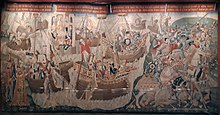Innogen

Innogen is a character in the respectively.
Historia Regum Britanniae

Innogen first appears in Geoffrey of Monmouth's Historia Regum Britanniae (c. 1136). She was the eldest daughter of the Greek king Pandrasus, and was given in marriage to Brutus of Troy after he united the enslaved Trojans in Greece and defeated Pandrasus to gain their freedom.[1]
When Innogen left Greece with Brutus and the Trojans, she was inconsolable at leaving her parents and country. They travelled through the Mediterranean, around the coast of Iberia and Gaul, and arrived in Britain, where it was prophesied that Brutus would found an empire.[1]
Innogen had three sons with Brutus, who divided his kingdom between them after his death: the eldest,
Her great-great grandson Ebraucus named one of his thirty daughters Ignogni, who was sent along with her sisters to Alba Silvius in Italy, where they were married to the Trojan nobility there.[3]
Analysis
Academic Fiona Tolhurst suggests that Innogen performs a pivotal function in the foundation of Brutus' Britain, by providing legitimacy to his rule through her bloodline, in the same way that Lavinia did for Aeneas.[4]
Innogen or its equivalent appeared in early Celtic documentations of the legend of Brutus likely to identify her only as being the daughter of Pandrasus, rather than to indicate her proper name.[citation needed]
Name
Innogen's name is spelled a number of different ways in the Historia Regum Britanniae, with the best readings being Innogen and Ignogen,[5] but other spellings include Ignoge, Euogen, and Ygnogen.[6]
The name is likely to be Celtic in origin, from Gaelic inghean (Irish iníon and Scottish Gaelic nighean), meaning 'daughter',[7] 'girl', or 'maiden'.[8][9] However, Innogen could instead be derived from the Latin name Innocentia,[5] with a possible intermediate Celtic form of the name being Enogent.[10] Since Innogen is a Greek character, other theories have suggested that it was intended to be a Greek name, with possible reconstructions ἐκγόνη (Ecgone, 'a daughter') or —ιγόνη (—igone), from the final part of a name such as Erigone or Antigone.[6][note 1] Some sources claim Innogen means 'beloved child' in Greek.[11] The name Imogen is also attested from before the Historia Regum Britanniae.[12][note 2]
Legacy

Modern uses of the name Imogen probably derive from a misspelling of Innogen in the 1623 First Folio edition of William Shakespeare's Cymbeline. Shakespeare probably took the name from a retelling of the story of Innogen and Brutus in Holinshed's Chronicles (1577), and had used the name Innogen once before for a non-speaking 'ghost character' in Much Ado About Nothing (1600). An early description of Cymbeline by Simon Forman in 1611 consistently spells the name of the character as "Innogen", and the spelling of the character's name as "Imogen" in the First Folio appears to have been the result of "scribal or compositorial error".[13]
Innogen was mentioned in the funeral orations of Anne of Brittany in 1514. In the oration, Guillaume Parvi traced Anne's ancestry back to Innogen, and recounted a story that explained the origin of her family's heraldic ermine coat of arms. According to the story, during a hunt at Le Croisic, a stoat being pursued by Brutus' dogs took refuge with Innogen, who saved and fed it, and adopted it for ordre et armes ('order and arms').[14]
Edmund Spenser mentioned Innogen in book two, canto ten of The Faerie Queene (1590), as "fayre Inogene of Italy".[15]
Innogen was a character in a lost play by Henry Chettle and John Day entitled The Conquest of Brute with the first finding of the Bath which was performed by the Lord Admiral's Men at the Rose in December 1598.
Notes
- ^ The theory that Innogen might be derived from —ιγόνη (—igone) was put forward by Peter Roberts. Roberts suggested that Geoffrey of Monmouth might have been reading a manuscript which had a Greek name such as Erigone or Antigone, but the first part of the name was illegible, leading him to form the name Innogen from the remaining readable part.[6]
- ^ Imogen of Dol, the sister of Rivallon I of Dol, died some time after 1064,[12] around seventy years before Geoffrey of Monmouth wrote the Historia Regum Britanniae (c. 1136).
References
- ^ a b Geoffrey of Monmouth. . Historia Regum Britanniae. Chapters 10–11 – via Wikisource.
- ^ Geoffrey of Monmouth. . Historia Regum Britanniae. Chapter 1 – via Wikisource.
- ^ Geoffrey of Monmouth. . Historia Regum Britanniae. Chapter 8 – via Wikisource.
- ISBN 978-1-137-32926-4.
- ^ a b Bartrum, Peter C. (2009) [1993]. "Innogen daughter of Pandrasus" (PDF). In MPS (ed.). A Welsh Classical Dictionary. Vol. 7. National Library of Wales. p. 442.
- ^ .
- ^ "1. ingen". eDIL. 2019.
- ISBN 9780191726675.
- ISBN 9780826458896.
- ^ Owen, Robert (1891). The Kymry. Carmarthen: W. Spurrell and Son. p. 48.
- ISBN 9780552122573.
- ^ ISSN 0954-9927.
- ISBN 978-0-19-870873-5.
- ISBN 9782070770618.
- .
